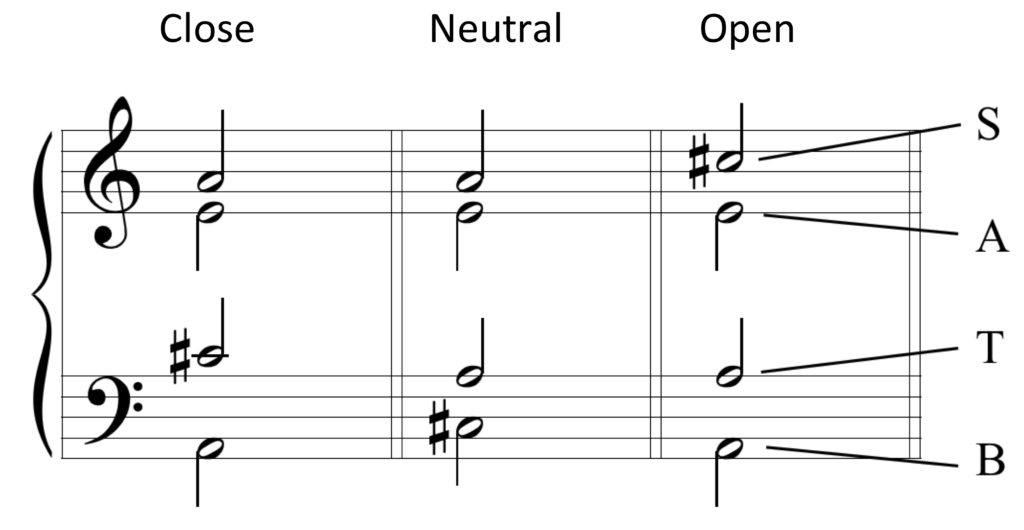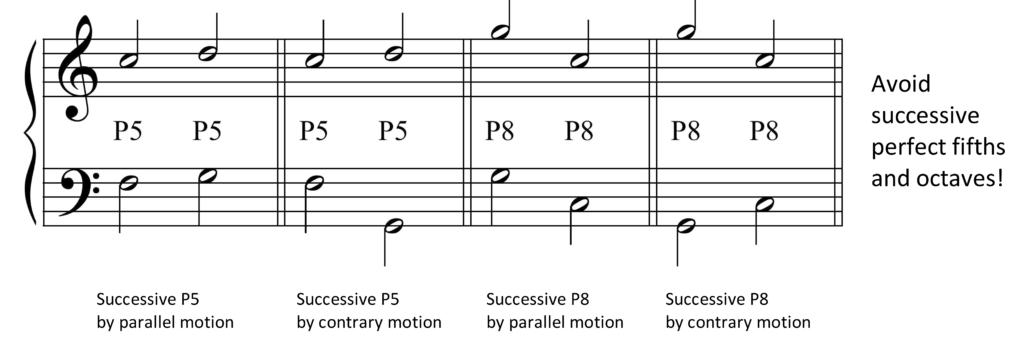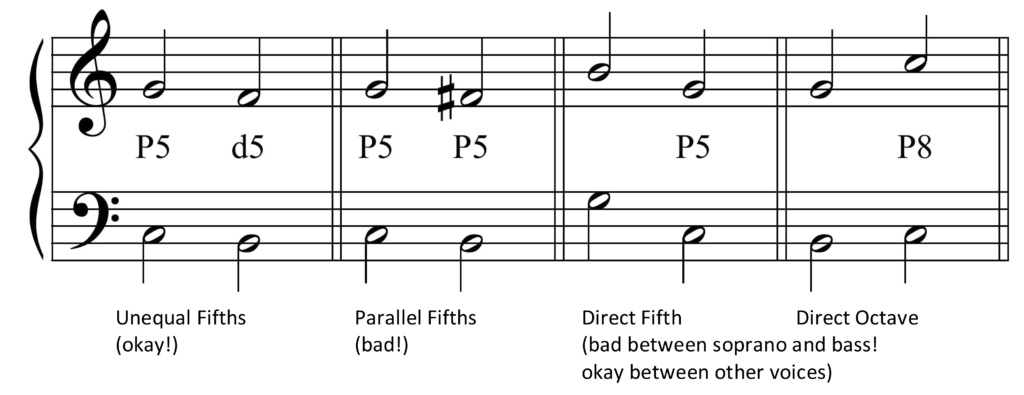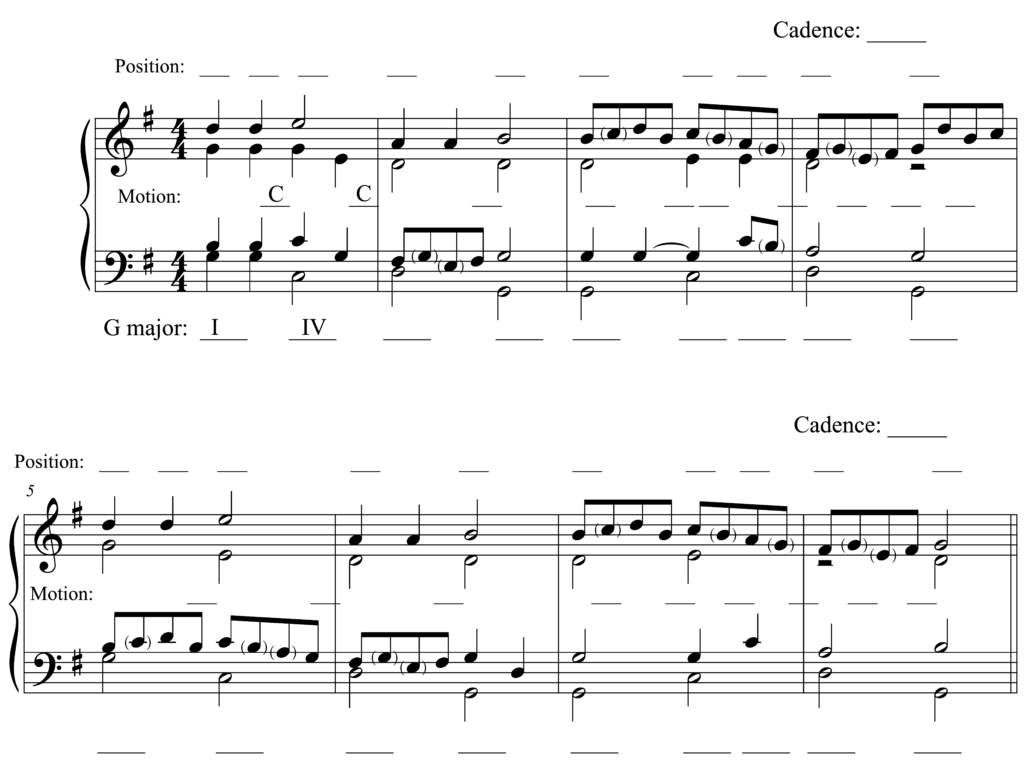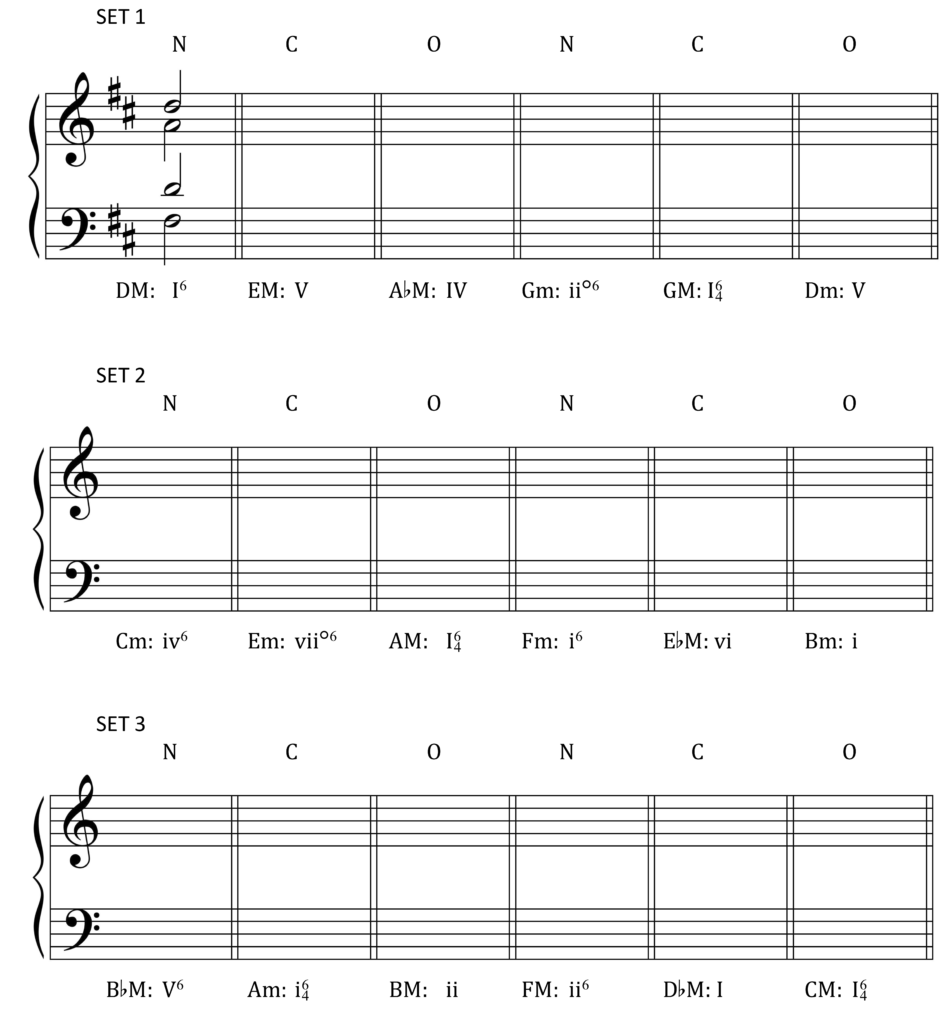Main Body
24 Chord motion and voicing
Learning goals for Chapter 24
In this chapter, we will:
- Study chord voicings in four-voice textures
- Learn about chord positions
- Revisit types of motion as they apply to chords in European Baroque, Classical, and Romantic music
Chord voicing
Often, the harmony in European tonal music is constructed as, or can be understood as, a four-part texture with soprano, alto, tenor, and bass () parts, even if a composition is not written for SATB choir. We can even extract four parts from textures written for keyboard instruments and sometimes even single-line instruments, such as the cello or violin, when compound melody is employed. This chapter introduces best practices for understanding harmony in European Baroque, Classical, and Romantic music, as well as for writing and connecting chords in these styles.
Chord positions
Chords can be voiced in one of three ways, as shown in Example 24-1: , , or position. Chords in close position have less than an octave between the soprano and tenor voices. Those in neutral position have exactly an octave between soprano and tenor, and those in open position have more than an octave between soprano and tenor. It is best to avoid having more than an octave between soprano and alto, or between alto and tenor, as this often results in an undesirable, empty, or muddy voicing.
Chord motion
In Chapter 21, we learned about four types of motion in two-part textures—, , , and —which are shown again in Example 24-2. These terms are also used to describe motion among parts in four-voice chord textures.
When connecting one chord to another, preserving the independence of the melodic lines should be a high priority. For this reason, contrary motion is most preferred, especially between the outer voices, and oblique motion also works well. Similar motion may occur between outer voices, but it tends to obscure independence more than contrary motion does. Parallel motion produces melodic lines that seem more dependent on each other, so it is generally avoided between outer voices; however, parallel thirds, fourths, and sixths do occur commonly between upper voices (soprano, alto, and tenor). Parallel perfect unisons, fifths, and octaves disguise independence so much that they are to be avoided between any two voices. Even when using contrary motion, consecutive perfect fifths and octaves must be avoided, as shown in Example 24-3.
Example 24-4 shows two other ways of approaching perfect fifths or octaves. occur between two voices that move from a d5 to a P5 or vice versa; unlike parallel fifths, unequal fifths are acceptable. occur when the soprano voice is approached by leap resulting in a P5 between soprano and bass, and result in a P8 by the same means; these should both be avoided in some tonal styles.
Video: T35 Chord motion and voicing (9:31)
This video introduces three chord voicing types (close, neutral, and open) and four types of chord motion (parallel, similar, oblique, and contrary). In addition, the video demonstrates the motion of parallel perfect fifths and octaves (to be avoided in European Baroque, Classical, and Romantic styles), as well as the distinction between unequal fifths (okay in these styles) and parallel fifths (not used in these styles).
EXERCISE 24-1 Chord motion and voicing
Part A. Study and listen to the example below. Label each chord position with O, N, or C (for , , and , respectively) and the cadences above the grand staff. Then label the motion between the bass and soprano voice with P, S, O, or C (for , , , or , respectively) between the staves. In cases where both the soprano and bass remain stationary, no label is needed (as no motion has occurred). Finally, provide a Roman numeral analysis beneath the grand staff. The first measure is done for you.
Worksheet example 24‑1. Samuel Scheidt, Bergamasca, mm. 1–8
Listen to the piece, performed by organist Klemens Schnorr, on Spotify.
Learn about German composer and organist Samuel Scheidt (1587–1654) by reading this Oxford Music Online article, written by Kerala J. Snyder and Douglas Bush.
Part B. For each problem, first provide the proper key signature, then realize the Roman numerals given beneath the staff in open (O), neutral (N), or close (C) position as indicated in four voices (SATB). If the triad is in , double the root, which is also the bass. If the triad is in (![]() ), double the soprano. If the triad is in (
), double the soprano. If the triad is in (![]() ), double the fifth, which is also the bass. The first problem is done for you.
), double the fifth, which is also the bass. The first problem is done for you.
abbreviation for four-voice music, referring to soprano, alto, tenor, bass; may apply to choral music or instrumental music in four parts
position for chords with less than an octave between the soprano and tenor voices
position for chords with exactly an octave between soprano and tenor
position for chords with more than an octave between soprano and tenor
the relationship between keys that have the same tonic, but a different key signature
motion resulting from two parts moving in the same direction (both up or both down)
motion in which one part moves, while the other stays on the same pitch
motion resulting from two parts moving in opposite directions (one up, the other down)
motion between two voices that move from a d5 to P5 or vice versa
type of motion occurring when the soprano voice is approached by leap resulting in a P5 between soprano and bass
type of motion occurring when the soprano is approached by leap resulting in a P8 between soprano and bass
designation for chords whose lowest note is also the root of the chord
position of a chord when its third is the lowest sounding note
position of a chord when its fifth is the lowest sounding note
